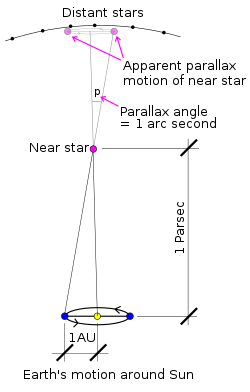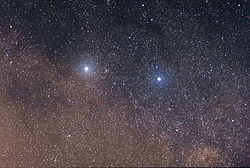In astronomy, parallax is the apparent shift in position of a nearby celestial object relative to distant background objects which is caused by a change...
28 KB (4,223 words) - 06:53, 22 June 2025
astronomical unit (AU). Stellar parallax is so difficult to detect that its existence was the subject of much debate in astronomy for hundreds of years. Thomas...
22 KB (2,824 words) - 23:04, 22 May 2025
Parsec (redirect from Parallax of one arc second)
form of a distance corresponding to a parallax of one second, coined by the British astronomer Herbert Hall Turner in 1913. The unit was introduced to simplify...
29 KB (3,340 words) - 04:38, 25 May 2025
a basis for other distance measurements in astronomy forming the higher rungs of the ladder. Because parallax is weak if the triangle formed with an object...
24 KB (3,003 words) - 21:08, 22 June 2025
important step on the cosmic distance ladder. Parallax in astronomy Photometric parallax method Dynamical parallax Distance modulus Carroll, Bradley W.; Ostlie...
3 KB (328 words) - 13:35, 2 February 2025
limited accuracy for individual measurements. Parallax in astronomy Spectroscopic parallax Dynamical parallax Mario Juric; et al. (2008). "The Milky Way...
1 KB (177 words) - 13:36, 2 February 2025
can be achieved. Parallax in astronomy Photometric parallax method Spectroscopic parallax Patrick Moore (2002). Philip's Astronomy Encyclopedia (revised...
3 KB (324 words) - 18:54, 22 November 2024
Astronomical unit (redirect from AU (astronomy))
a solar parallax of 8.6″. Although Huygens' estimate is remarkably close to modern values, it is often discounted by historians of astronomy because of...
53 KB (5,401 words) - 18:35, 14 June 2025
sciences, achieving a high level of success in the second half of the first millennium. Astronomy has origins in the religious, mythological, cosmological...
85 KB (10,461 words) - 03:01, 21 May 2025
Moving-cluster method (redirect from Moving cluster parallax)
2M1207b using the moving-cluster method. Astrometry Parallax Parallax in astronomy Stellar parallax Cepheid Stars RR Lyrae Variable Stars Mamajek (2005)...
3 KB (447 words) - 15:23, 5 April 2023
Astronomy is a natural science that studies celestial objects and the phenomena that occur in the cosmos. It uses mathematics, physics, and chemistry...
103 KB (10,550 words) - 08:58, 9 June 2025
Pleiades (redirect from Pleiades (astronomy))
dissenting evidence. In 2012, Francis and Anderson proposed that a systematic effect on Hipparcos parallax errors for stars in clusters would bias calculation...
50 KB (5,466 words) - 00:58, 14 June 2025
In astronomy, aberration (also referred to as astronomical aberration, stellar aberration, or velocity aberration) is a phenomenon where celestial objects...
60 KB (8,086 words) - 22:58, 29 May 2025
Tycho Brahe (redirect from Tycho's observational astronomy)
not sufficiently steady. His unprecedented research program both turned astronomy into the first modern science and also helped launch the Scientific Revolution...
97 KB (12,440 words) - 21:15, 19 June 2025
Polaris (section In popular culture)
1023/A:1005081918325. S2CID 189785021. Van Leeuwen, F. (2013). "The HIPPARCOS parallax for Polaris". Astronomy & Astrophysics. 550: L3. arXiv:1301.0890. Bibcode:2013A&A....
53 KB (5,092 words) - 16:46, 15 June 2025
Sirius (redirect from Sirius in fiction)
Cape (no sensible parallax); by Bessel (no sensible parallax). Scottish astronomer Thomas Henderson used his observations made in 1832–1833 and South...
100 KB (10,264 words) - 01:41, 23 June 2025
List of nearest stars (category Lists of superlatives in astronomy)
parallax. Brown, A. G. A.; et al. (Gaia collaboration) (2021). "Gaia Early Data Release 3: Summary of the contents and survey properties". Astronomy &...
118 KB (5,560 words) - 02:26, 22 June 2025
Lunar distance (redirect from Lunar distance (astronomy))
L}} ), or Earth–Moon characteristic distance, is a unit of measure in astronomy. More technically, it is the semi-major axis of the geocentric lunar orbit...
42 KB (4,408 words) - 02:03, 26 May 2025
James Bradley (category Savilian Professors of Astronomy)
Astronomer Royal from 1742. He is best known for two fundamental discoveries in astronomy, the aberration of light (1725–1728), and the nutation of the Earth's...
15 KB (1,651 words) - 01:58, 13 June 2025
Sun (redirect from Sun (astronomy))
in 1684 by Giovanni Domenico Cassini. Knowing that direct measurements of the solar parallax were difficult, he chose to measure the Martian parallax...
173 KB (19,378 words) - 15:47, 16 June 2025
earlier epoch of stellar evolution. stellar parallax stellar remnant submillimetre astronomy The subfield of astronomy that studies astronomical objects detectable...
171 KB (19,837 words) - 05:15, 23 June 2025
Geocentric model (redirect from Ptolemaic astronomy)
In astronomy, the geocentric model (also known as geocentrism, often exemplified specifically by the Ptolemaic system) is a superseded description of the...
74 KB (8,585 words) - 04:09, 26 May 2025
Observational astronomy is a division of astronomy that is concerned with recording data about the observable universe, in contrast with theoretical astronomy, which...
27 KB (3,381 words) - 12:00, 22 April 2025
Ancient Greek astronomy is the astronomy written in the Greek language during classical antiquity. Greek astronomy is understood to include the Ancient...
34 KB (4,243 words) - 23:49, 19 June 2025
Epoch Equinox Halley, Edmond History of Astronomy Jyotish Kepler's laws of planetary motion Occultation Parallax Retrograde and prograde motion Sidereal...
6 KB (662 words) - 17:07, 22 October 2023
Vega (redirect from Vega (astronomy))
First Parallax Measurements". Astroprof. Retrieved November 12, 2007. Perryman, M. A. C.; et al. (1997). "The Hipparcos Catalogue". Astronomy and Astrophysics...
98 KB (10,326 words) - 20:15, 20 June 2025
Samuel Rowbotham (redirect from Parallax (pseudoscientist))
Earther who wrote Zetetic Astronomy: Earth Not a Globe under the pseudonym Parallax. His work was originally published as a 16-page pamphlet (1849), and later...
8 KB (1,082 words) - 20:46, 4 June 2025
Alpha Centauri (category Astronomical objects discovered in 1689)
(1989). A History of Astronomy. Courier Corporation. p. 333. ISBN 978-0-486-65994-7. Maclear, M. (1851). "Determination of parallax of α1 and α2 Centauri"...
122 KB (11,798 words) - 20:37, 22 June 2025
suggested an aircraft design similar to his own. When he discovered Parallax's Zetetic Astronomy he was an instant convert. "What the authorities were concealing...
11 KB (1,269 words) - 03:22, 17 January 2025
Galileo Galilei (redirect from Father of modern observational astronomy)
polymath. He was born in the city of Pisa, then part of the Duchy of Florence. Galileo has been called the father of observational astronomy, modern-era classical...
135 KB (16,641 words) - 08:43, 17 June 2025























